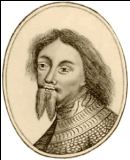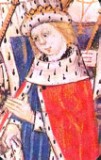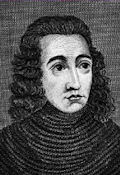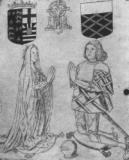17 AUGUST 1473
 Birth of Richard of Shrewsbury, second son and sixth child of Edward IV and Elizabeth Woodville, at Shrewsbury.
Birth of Richard of Shrewsbury, second son and sixth child of Edward IV and Elizabeth Woodville, at Shrewsbury.
Tags: Edward IV, Elizabeth Woodville, Family
 At a meeting of Parliament Richard Plantagenet, 3rd Duke of York, claims his right to the English crown. A compromise is reached and sworn on in an Act of Accord, according to which the Duke of York is the heir to the throne instead of Henry VI’s son Edward.
At a meeting of Parliament Richard Plantagenet, 3rd Duke of York, claims his right to the English crown. A compromise is reached and sworn on in an Act of Accord, according to which the Duke of York is the heir to the throne instead of Henry VI’s son Edward.
Tags: Family, Henry VI, Richard Duke of York
 Birth of Richard of Shrewsbury, second son and sixth child of Edward IV and Elizabeth Woodville, at Shrewsbury.
Birth of Richard of Shrewsbury, second son and sixth child of Edward IV and Elizabeth Woodville, at Shrewsbury.
Tags: Edward IV, Elizabeth Woodville, Family
 Birth of Anne of York, seventh child and fifth daughter of Edward IV and Elizabeth Woodville, at Westminster Palace. Married to Thomas Howard, 2nd Earl of Surrey, the son of Richard’s close associate John Howard. Died 11 November 1511, buried first at Thetford Priory, Norfolk, but relocated after the Reformation to the Church of St Michael the Archangel, Framlingham.
Birth of Anne of York, seventh child and fifth daughter of Edward IV and Elizabeth Woodville, at Westminster Palace. Married to Thomas Howard, 2nd Earl of Surrey, the son of Richard’s close associate John Howard. Died 11 November 1511, buried first at Thetford Priory, Norfolk, but relocated after the Reformation to the Church of St Michael the Archangel, Framlingham.
Tags: Edward IV, Elizabeth Woodville, Family
 Birth of Edward, eldest son and fourth child of Edward IV and Elizabeth Woodville, in sanctuary at Westminster Abbey.
Birth of Edward, eldest son and fourth child of Edward IV and Elizabeth Woodville, in sanctuary at Westminster Abbey.
Tags: Edward IV, Elizabeth Woodville, Family
 Birth of George Plantagenet, Duke of Clarence, third of the four sons of Richard Plantagenet, 3rd Duke of York, and Cecily Neville who survived to adulthood. He was born in Dublin, as his father was at that time lord lieutenant of Ireland.
Birth of George Plantagenet, Duke of Clarence, third of the four sons of Richard Plantagenet, 3rd Duke of York, and Cecily Neville who survived to adulthood. He was born in Dublin, as his father was at that time lord lieutenant of Ireland.
Tags: Family, George of Clarence
Kris contacted our branch a while ago hoping we might be of assistance in her genealogical research. We understand that Kris is especially interested in the Durnford link, so if any of readers could help Kris further, please let us know (webmaster “AT” richardiii-nsw.org.au) and we will gladly pass your message on to Kris.
Jigsaws, we have all done them. They are an excellent tool for keeping our minds active and provide challenges for people of all ages, when the pieces start to fit together to complete the picture. In solving Family History puzzles, some surprises can be unearthed!
Firstly I tackled my father-in-laws family, and being from convicts from the First Fleet, they are now known as the Royalty of Australia. That project took about 3 years and resulted in developing a website.
The next family line was my own. The lack of information at times made be almost give up, until I decided to work on my grandmother’s family, the Durnfords. There were lots of rather famous relatives among the Durnfords, many of them highly decorated in the British Military for their prowess on the battlefield, to their ability in engineering new cities in America, Canada and the West Indies.
Along the way, some of them married 3 or 4 times, and had numerous children. The Durnford family is worldwide, and has its own website. One arm of the family became known as the “Military” Durnfords. It is to the line that we Australian Durnfords are related.
While living in the past centuries and reading of their lives with the research that was available, I found that I could research their direct lineage back to King William the Conqueror. That was a shock. But to even be able to go back to the different Royals of the European countries was certainly an experience.
I loved geography when at school, but refrained from studying British History, and suddenly I was surrounded by it day in day out, as I took to the researching almost as a full time job.
 We decided then to take a 3 month trip and “walk in our ancestors’ footsteps”. We planned a driving route that would take us to many of the towns where I knew these people had lived or died, or where they had fought in a battle or two, or where they had built amazing buildings.
We decided then to take a 3 month trip and “walk in our ancestors’ footsteps”. We planned a driving route that would take us to many of the towns where I knew these people had lived or died, or where they had fought in a battle or two, or where they had built amazing buildings.
Nothing could have prepared me for what we discovered.
We arrived in Leicester, and on a wet, cold and rainy day, decided to find the Cathedral, because one line of the family Herrick. The hostess an elderly lady told us that the Herrick’s were buried in St Katherine’s Chapel, and she eagerly took us there. I mentioned to her that I had discovered King Richard III was among my family ancestors. She then showed us where King Richard was to be reburied, on a spot immediately outside the chapel.
 She also told me that she didn’t think she had seen any other relatives of the Herricks retracing their lives, and was a bit impressed. She sent us off to the adjoining Guildhall where the Mayor’s offices were.
She also told me that she didn’t think she had seen any other relatives of the Herricks retracing their lives, and was a bit impressed. She sent us off to the adjoining Guildhall where the Mayor’s offices were.
I was a bit overwhelmed, all the names of Herricks that I had no knowledge of who they all were! The memorials covered the walls of the chapel, which is at the front of the Cathedral to the left hand side (east), it has an altar and beautiful stained glass windows.
But I found the grave stones of Robert Herrick and Elizabeth Manby.
They are my 10th great grandparents.
 Here lyeth the bodie of Robert Herick Ironmonger and Alderman of Leicester who had beene thrice Maire thereof. He was eldest sonne to John Herick and Marie, and had 2 sonnes and 9 daughters by one wife with whom he lived 51 years. At his death he gave away 16 pounds 10 shillings a year to good uses. He lived 78 years; and after dyed very godly the 14th of June 1618.
Here lyeth the bodie of Robert Herick Ironmonger and Alderman of Leicester who had beene thrice Maire thereof. He was eldest sonne to John Herick and Marie, and had 2 sonnes and 9 daughters by one wife with whom he lived 51 years. At his death he gave away 16 pounds 10 shillings a year to good uses. He lived 78 years; and after dyed very godly the 14th of June 1618.
Then I learnt that they owned Greyfriers, the land adjacent to the Cathedral where King Richard III was initially buried after the Battle of Bosworth. Now if that wasn’t an amazing discovery
We returned from our trip with all this new information and an added research purpose to link all the ancestors and write about their lives.
In doing so, I was able to trace our lineage through the La Zouche family, who were the great grandparents (a few times) of King Richard. That line continued to the Herricks.
How ironic that while King Richard III was unceremoniously put to rest on the land later known as Greyfriers, that he would be re-buried in the same Cathedral, just a few steps away from the owners of the same land.
I am sure they would not have been aware that a long lost King was also a long lost cousin!
The father of Christopher Wren wrote in his diary that he had seen a marker indicating that King Richard III was buried in Leicester on the Herrick’s land.
Why was he there? Because he was a tutor at Oxford and his pupils were none other than Herrick children
This is one piece of my family jigsaw that is of significant historical importance!
From my blog www.edurnford.blogspot.com.au
Eldest son of AId. John Heyrick, mayor in 1557; born at Leic. in 1540, was one of the forty-eight councillors 1567, M.P. for Leic. 1588, a J.P. and alderman, and again mayor 1593 and 1605.
There were 5000 residents for all these councillors!
Ald. Robert Heyrick married at St. Martin’s 11 November 1567 Elizabeth, daughter of Ald. Wm. Manby of Leic., by whom he had a numerous family (vide St. Martin’s registers). For some years prior to his death, he resided in a mansion house within the precincts and grounds of the dissolved Grey Friars monastery, nearly opposite St. Martin’s church.
Here he died 14 June 1618 aged seventy-eight, and was buried at St. Martin’s two days later. M.I. there. Will dated 26 March 1617, was proved in the P.C.C., London, 30 July 1618. His portrait, with that of his younger brother Sir William Heyrick of Beaumanor Park, is still preserved in the Guildhall.
A townsman of note, and one of the most influential and active members of the corporate body of his time. In 1598, in conjunction with his younger brother Sir William Heyrick of London, goldsmith, later of Beaumanor, he obtained a confirmation of the ancient family arms, with the addition of this crest :-A bull’s head argent, the muzzle ears and horns tipped sable, gorged with a chaplet of roses leaved vert. The family motto VIRTUS NOBILlTAT being adopted by later members of the family.
Second son of Thomas Heyrick of Leic., and brother of AId. Nicholas Heyrick (No. 167). He was born in 1513, enrolled a freeman 1534-5, elected a chamberlain 1543-4, and again mayor 1572. He resided in the Saturday market at the corner of Cheapside ; married Mary, daughter of John Bond of Ward End, co. Warwick, who died in 1611, by whom he had five sons and seven daughters.
Here lyeth the bodie of Robert Herick Ironmonger and Alderman of Leicester who had beene thrice Maire thereof. He was eldest sonne to John Herick and Marie, and had 2 sonnes and 9 daughters by one wife with whom he lived 51 years. At his death he gave away 16 pounds 10 shillings a year to good uses. He lived 78 years; and after dyed very godly the 14th of June 1618.
Robert Herrick (also spelled Heyrick, 1540-1618), from a family of successful ironmongers, followed in his father’s footsteps as Mayor of Leicester, holding the position in 1584, 1593 and 1605.
Sir Robert Catlyn, Chief Justice to Elizabeth I, acquired the site from Bellowe and Broxholme, and it was later bought by Robert Herrick (Heyrick), three times mayor of Leicester. Herrick built a mansion fronting onto Friar Lane, with extensive gardens over the east end of the Friary grounds.
These gardens were visited by Christopher Wren Sr. (1589–1658) in 1611, who recorded being shown a handsome stone pillar with an inscription, “Here lies the body of Richard III, some time King of England”.
The Herrick family, who also owned the country estate of Beaumanor, near Loughborough, sold the mansion to Thomas Noble in 1711,who, like Herrick 130 years before him, represented Leicester in Parliament.
He was also a Justice of the Peace and at various times the town’s Chamberlain, Coroner and MP.
The Mayoral Roll records: “For some years prior to his death, he resided in a mansion house within the precincts and grounds of the dissolved Grey Friars monastery, nearly opposite St Martin’s church.”
Herrick built a house on the eastern part of the grounds, visited in 1612 by a young man named Christopher Wren, who was tutor to Herrick’s nephew at Oxford. (This was not the famous architect but his father, later Dean of Windsor.)
Wren wrote in his diary that Herrick showed him a stone pillar with an inscription ‘here lies the body of Richard III, some time King of England’. This was the last recorded location of Richard’s body.
Herrick’s daughter Frances married Thomas Noble and one of their descendants (also Thomas Noble, c.1656-1730, later the town’s MP) bought the Greyfriars land in 1711.
His son, yet another Thomas, divided the site into two in 1740 with the appropriately named New Street, along which houses were built, with numerous burials discovered during the building work. Herrick’s house and garden passed in 1743 to Roger Ruding of Westcotes, in 1752 to hosier Richard Garle, and in 1759 to banker William Bentley who built a fine house with the address ‘17 Friar Lane’.
Archaeologists from the University of Leicester who are leading the search for the lost grave of King Richard III announced today that they have made a new advance in their quest.
They have uncovered evidence of the lost garden of Robert Herrick – where, historically, it is recorded there was a memorial to Richard III.
Now the ‘time tomb team’ as they have become to be known has discovered paving stones which they believe belong to the garden.
The University of Leicester is leading the archaeological search for the burial place of King Richard III with Leicester City Council, in association with the Richard III Society.
In 1485 King Richard III was defeated at the battle of Bosworth. His body, stripped and despoiled, was brought to Leicester where he was buried in the church of the Franciscan Friary, known as the Grey Friars. Over time the exact whereabouts of the Grey Friars became lost.
Tags: Family, Leicester, Richard III
It is a tradition in the NSW branch that at the August general meeting we have “Scrabble Talks”. Once a year, members draw Scrabble tiles out of a bag and then prepare a short talk on a topic starting with their letter. The following is Judy’s talk on ‘Duchess Anne of Exeter’. This was a particularly fitting, as the day before our meeting was Duchess Anne’s birthday.
I’ve been allocated the letter ‘A’ for my talk at the August general meeting of the NSW branch, so I would like to tell you about Princess Anne Plantagenet, better known as Duchess Anne of Exeter, who was the eldest sister of Edward IV and Richard III and apparently Edward’s favourite sibling. You will be familiar with this memorial brass to Anne and her second husband, which I think is the only likeness of her to survive.

Anne’s story is a very good example of a high born woman who became a pawn in the political manoeuvres of her male relatives. But we can presume she found happiness towards the end of her life.
Anne was born in 1439 and was the eldest surviving child of the Duke of York and Cecily Neville. She was betrothed in 1445 at the age of 6 years to Henry Holland, who was 15 years old and the son of the Duke of Exeter. York paid a huge dowry of 4,500 marks, the largest known in late medieval England. Within five years of this, you will recall, was around the time that the King, Henry VI, began showing signs of his illness and the Wars of the Roses was beginning to seriously foment. It is believed York’s motive in securing the betrothal was partly political and he was hoping for Exeter’s alliance in his attempt to return to France. It was also a dynastic move as Exeter was the next closest male relative of Henry VI and descended from John of Gaunt and Blanche of Lancaster. York took the opportunity to combine two great dynasties but in fact, in both personal and political terms, it was a disaster.
Anne and Henry married soon after their betrothal and Henry inherited his father’s titles and land in 1450 and as the Duke of Exeter and became admiral of England, Ireland & Aquitaine and Constable of the Tower of London. Their first and only child, also called Anne, was born in 1455, and she went on to marry Elizabeth Woodville’s son, Thomas Grey in 1467. The young Duke of Exeter, Henry, was described as an unappealing character, violent, cruel and lacking in any real experience and was unintelligent – not the makings of a great husband or political ally!!
During York’s Protectorate in 1453 – 54, young Exeter (York’s son-in-law) played a prominent role in the serious breakdown of local law and order and the uncontrollable violence, particularly in Yorkshire which was York’s biggest challenge during his protectorate, seems to have been perpetrated by Exeter himself. Exeter planned a major uprising in the north and may have even plotted to murder York by luring him to Yorkshire.
It was unlikely that Duchess Anne was able to escape the animosity Exeter felt towards his wife’s father, given his character. In addition, York defaulted on the later instalments to her dowry, which is understandable but would not have helped the relationships. Anne did have a child with Exeter in 1455 but we can presume that the marriage broke down soon after.
Exeter was a staunch Lancastrian during the descent into Civil War and he became a very bitter enemy of York and the Nevilles. Exeter thought, as the King’s closest relative, he was entitled to a prominent role in government and he was not happy when York began to advance his own claims as King Henry’s heir presumptive. As a committed Lancastrian, Exeter joined forces with Somerset, Northumberland and others in opposition, which culminated in the death of York, his son Edmund and brother-in-law Salisbury at Wakefield in 1460.
In 1461 Exeter fought for the Lancastrians at the battles of Blore Heath, Northampton, St Albans and Towton and even though defeated, he continued to be aligned with the Somerset and the other hard-core Lancastrians. This caused further and continuing difficulties for the new King Edward in his attempts to establish his rule and find a collegiate solution to the regional turmoil caused by the civil war. Exeter escaped overseas and was attainted by parliament and his estates were granted to his wife – one advantage of being the new King’s sister. Exeter lived in poverty during his exile until the Duke of Burgundy gave him a modest pension. But remember that the Duke of Burgundy was soon to become Edward’s brother-in-law when he married Princess Margaret of York.
Anne at this stage was still married to Exeter and was herself the second lady in the land after the King’s mother, Cecily.
Anne, around this time, began a relationship with Sir Thomas St Ledger who became her lover (who could blame her!!). Thomas was made an esquire of the body to Edward IV and was granted eight manors in Buckinghamshire and Cambridgeshire, including a royal manor, and received a number of other wardships and grants. Here, and in the granting of Exeter’s estates to her, Anne benefited considerably from being the King’s sister.
Thomas proved to be a loyal member of the King’s household, he resisted Clarence and Warwick in 1469 – 1470 and he even joined Edward in exile in 1470.
But, not to be forgotten, that flea Exeter returned to England and commanded the left wing of Warwick’s army at Barnet in April 1471 and in doing so opposed his 3 brothers-in-law, Edward, Richard & Clarence. He was seriously wounded on the battlefield but eventually recovered to be imprisoned in the Tower of London. Anne finally got her divorce from Exeter and she married her lover Thomas St Ledger the next year.
But Exeter was not to be put down so easily, he was released from custody in 1475 to join Edward’s French expedition but on the return journey he drowned in the English Channel, reputedly thrown overboard with the King’s knowledge. A fitting end for such a despicable character. I wonder what Anne thought??
Tragically for Anne, though, her daughter with Exeter died the same year.
The next year in 1476, Anne gave birth to a second daughter also called Anne, but unfortunately Duchess Anne herself died, probably in childbirth. The infant Anne, whose father was Thomas St Ledger, was to marry George Manners and become the Baroness Ros and have two children, one of whom became the 1st Earl of Rutland. This title has remained in their family until today – Duchess Anne and her lover Thomas had established a very successful and long lasting dynasty.
But to continue the story of the people in Duchess Anne’s life: after Edward’s death in 1483, Anne’s second husband Thomas St Ledger attended Richard III’s coronation but in July of that year he was dismissed from all posts. He became closely aligned with Thomas Grey, Marquis of Dorset, and a leader in the Buckingham Revolt around Exeter and held out against the royal forces at Bodmin Castle until mid-November. Thomas St Ledger was executed a few days after. How sad for Anne, but we do not truly understand the circumstances of this period and cannot understand the extremes of emotion that Edward’s old household felt given the events which followed Edward’s death and Richard’s subsequent coronation.
We also do not know much about Duchess Anne as a person, which is not unusual for women of this period. However in 1491 her daughter by her second husband Thomas, founded in her honour the Rutland Chapel, as it is now called, in the north transept of St George’s Chapel at Windsor, just down the aisle from Edward IV’s vault. The memorial brass to Anne and Thomas is on the east wall of this chantry chapel.
The Chantry, although established for her parents, also contains a fine tomb chest and alabaster effigies of Anne junior and her husband George Manners, the 12th Baron Ros. These effigies are very fine examples of the period. (You can find photographs of these here)
The Rutland Chantry is a beautiful place to visit and is still used regularly for services at St George’s Chapel. It has some very beautiful new tapestries hanging within, along with some new furniture and today remains a very peaceful place of worship and contemplation. A fine memorial to Duchess Anne.
Tags: Edward IV, Family, Richard III, Wars of the Roses
 May promises to be an interesting month for friends of Ricardian fiction. Anne Easter Smith’s much anticipated novel about Cecily Neville, Queen by Right, will be published early in the month. This book on the mother of Edward IV and Richard III should be a real treat, as anyone who has read Anne’s previous books can confirm, including A Rose for the Crown, Daughter of York and The King’s Grace. These are what historical fiction should be: well-researched and sticking to the facts as we know them with some romance mixed in.
May promises to be an interesting month for friends of Ricardian fiction. Anne Easter Smith’s much anticipated novel about Cecily Neville, Queen by Right, will be published early in the month. This book on the mother of Edward IV and Richard III should be a real treat, as anyone who has read Anne’s previous books can confirm, including A Rose for the Crown, Daughter of York and The King’s Grace. These are what historical fiction should be: well-researched and sticking to the facts as we know them with some romance mixed in.
We now hear that Joan Szechtman will continue with the adventures of Richard III in This Time also in May in Loyalty Binds Me. In This Time we shared Richard’s experiences when he has been transported by time travel from the moment before his death into present day America.
Lots to look forward to in May.
Tags: Books, Cecily Neville, Family, Ricardian Authors, Richard III
 Death of Anne of York, Countess of Surrey. She was the seventh child and fifth daughter of Edward IV and Elizabeth Woodville.
Death of Anne of York, Countess of Surrey. She was the seventh child and fifth daughter of Edward IV and Elizabeth Woodville.
Tags: Edward IV, Elizabeth Woodville, Family, November
This continues my quest to discover a Ricardian or Yorkist connection to places in Hertfordshire. Hatfield was fairly high on my agenda as I spent a year as a foreign language assistant teaching German at two schools, one of which was in Hatfield, in 1980/81.
After arriving on a Saturday evening in late August 1980, our first visit the next day was to Hatfield House. As the first thing you see is the latest building on the site, this story will be going chronologically backwards. Read the rest of this entry »
Tags: Church, Family, Hertfordshire, Yorkshire